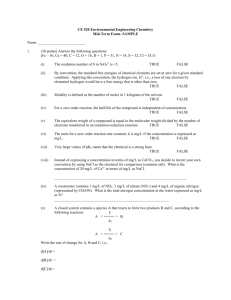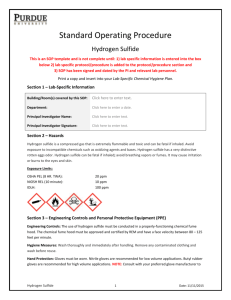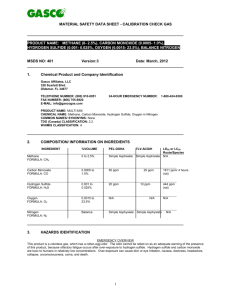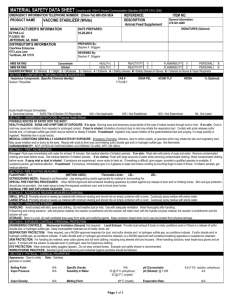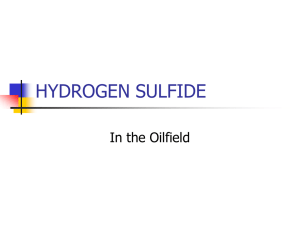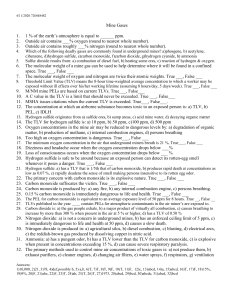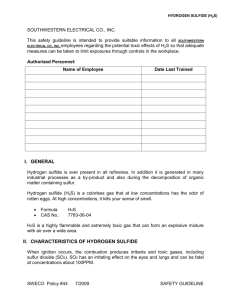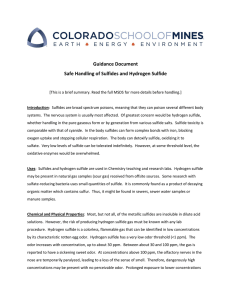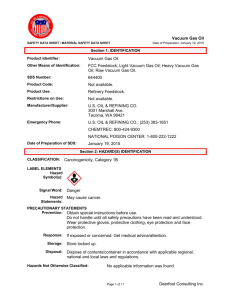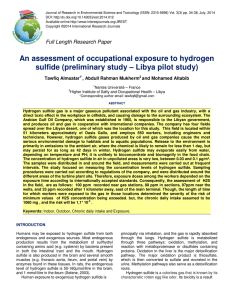BENZENE AWARENESS SAFETY
advertisement
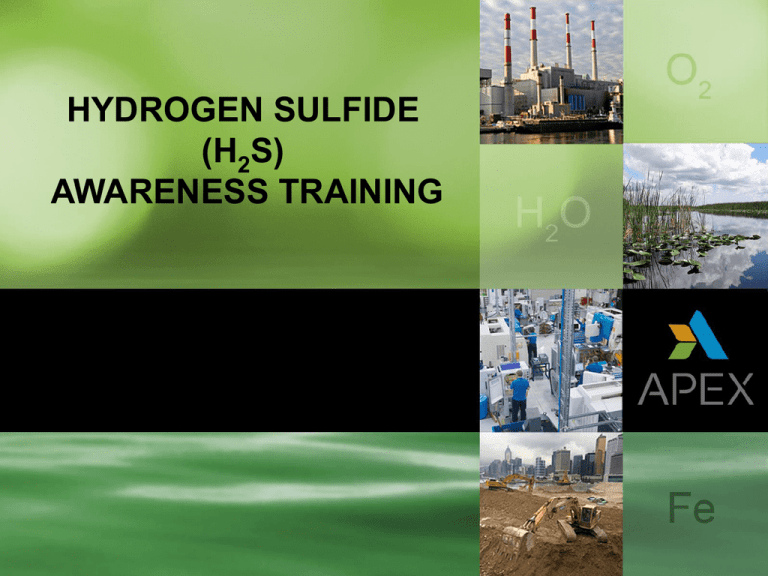
HYDROGEN SULFIDE (H2S) AWARENESS TRAINING HYDROGEN SULFIDE AWARENESS (H2S) Hydrogen sulfide presents a potential hazard to workers at many work sites. occurs as an unwanted by-product many different industries or occupations. ensure protection against exposure be aware of its properties, what to do in emergency situations. HYDROGEN SULFIDE AWARENESS (H2S) Hydrogen sulfide is also produced by the putrefication of organic matter. It may accumulate in sewers, sewage treatment plants. PHYSICAL AND CHEMICAL CHARACTERISTICS • • • • highly toxic, poisonous gas deadly to humans has no visible color. It is soluble in hydrocarbons and water at a ratio of 4: 1, • highly corrosive to certain metals due to either hydrogen embrittlement or sulfide stress cracking. PHYSICAL AND CHEMICAL CHARACTERISTICS • flammable when mixed with air at a temperature of 500 degrees F, • lower flammability limit is 4.3% while the upper flammability limit is 46% by volume in air. • When ignited, H2S produces Sulfur Dioxide (SO2) which is extremely hazardous and may leave victims disabled with pneumonia or respiratory damage. PHYSICAL AND CHEMICAL CHARACTERISTICS • is 20% heavier than air, and can be dispersed great distances with only a slight breeze • unidentified locations about refineries or industrial settings could indicate detectable levels of H2S • may include low lying areas such as: utility vaults, pits, ditches, trenches, confined spaces, inside dikes, or poorly ventilated areas. PERSONAL DETECTION • H2S also known as Rotten-Egg Gas • or Sour Crude • can be easily detected due to a strong odor of rotten eggs, or • to others, a sweet, offensive, sickening odor PERSONAL DETECTION Although it can be detected at a low concentration of 1 ppm, this early warning property should not be depended upon as an accurate indicator of its presence. Hydrogen sulfide detection by your nose may not occur as a concentration of this gas between 100 and 150 ppm can deaden your sense of smell. HEALTH EFFECTS • rapidly-acting systemic poison • causes respiratory paralysis and asphyxia • can irritate the eyes and respiratory tract at low concentrations. • a concentration greater than 700 ppm, inhalation may cause coma and/or death after a single breath. HEALTH EFFECTS • Each individual person may be affected differently by different concentration levels. • Some individuals are more sensitive. • If you should smell the presence of H2S or hear warnings from monitor alarms, then immediately evacuate this area. HEALTH EFFECTS Classed as a chemical asphyxiate Similar to carbon monoxide and cyanide gases. Inhibits cellular respiration and uptake of oxygen, causing biochemical suffocation. TYPICAL EXPOSURE SYMPTOMS 0 - 10 ppm - Irritation of the eyes, nose and throat 10 - 50 ppm - Headache, Dizziness, Nausea and vomiting, Coughing and breathing difficulty 50 - 200 ppm - Severe respiratory tract irritation, Eye irritation / acute conjunctivitis, Shock, Convulsions, Coma, Death in severe cases TYPICAL EXPOSURE SYMPTOMS Prolonged exposures at lower levels can lead to: • • • • • bronchitis, pneumonia, migraine headaches, pulmonary edema, and loss of motor coordination. MONITORING Exposure should be minimized by employing adequate engineering controls and safe working practices. Where engineering controls cannot adequately control levels of exposure, it may be necessary to supplement them with the use of suitable personal protective equipment (PPE) such as supplied-air respirators. MONITORING Identification of hydrogen sulfide concentrations may require monitoring. The exposure limit should be set to alarm at a concentration of 10 ppm. FIRST AID First aid needs will depend on the concentration level Do not immediately rush to the aid of an affected coworker unless properly trained and without protecting yourself with proper PPE. FIRST AID Signs and symptoms of an exposure: • respiratory paralysis by inhalation, • burning sensation of the eyes due to contact, • or skin irritation. FIRST AID Inhalation - remove victim to fresh air immediately. If not breathing, administer mouth-to-mouth artificial respiration until medical assistance arrives If breathing is restored but slow and labored, administer 100% oxygen by canister/mask as H2S is rapidly detoxified by the body. Maintain normal body temperature. Transportation to medical services should follow immediately. FIRST AID Eye or skin contact - should be treated by a 15 minute wash/flush at a safety shower/eye-wash station. If irritation or discomfort persists, transportation to medical services should follow immediately. REFERENCES Regional poison control center: 1-800-222-1222 Centers for Disease Control and Prevention Public Response Hotline (CDC) 800-CDC-INFO 888-232-6348 (TTY) E-mail inquiries: cdcinfo@cdc.gov Centers for Disease Control and PreventioN (CDC), National Institute for Occupational Safety and Health (NIOSH), Pocket Guide to Chemical Hazards

